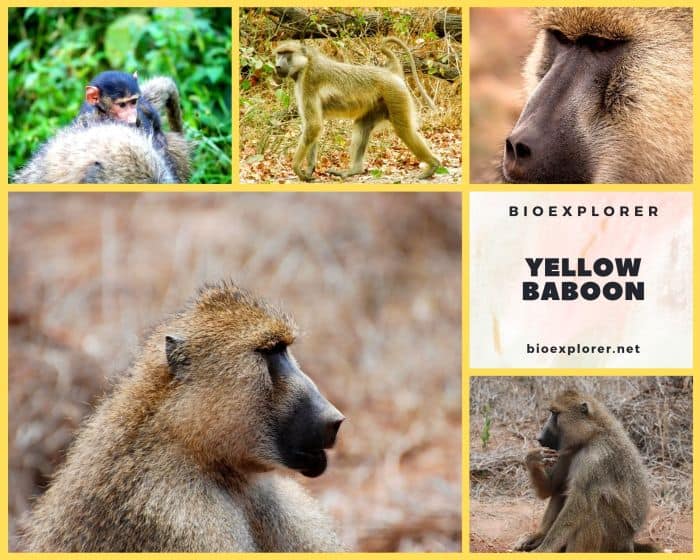
| Animalia | Primates | Cercopithecidae | Papio | Papio cynocephalus |
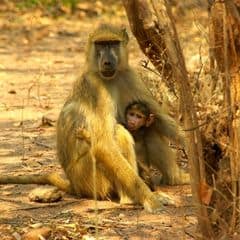

- Common Name: Yellow Baboon
- Taxonomy Classification Year: 1766
- Monkey Size: 60 to 84 cm (23.6 to 33.07)
- Skin Color(s): Yellow and white
- Habitat: Savanna or grassland, chaparral, forest, scrub forest
- Diet: Omnivorous
- Native Countries: Kenya, Tanzania, Zimbabwe, Botswana
Yellow Baboon Distribution
Yellow Baboon Characteristics
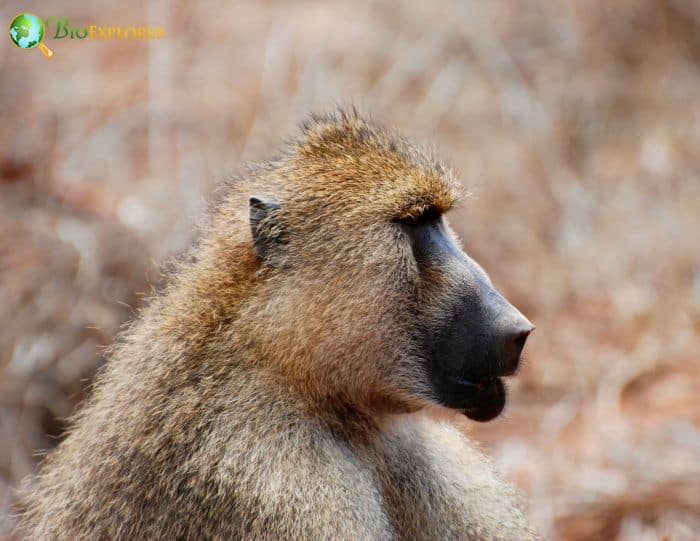
The yellow baboon[1] (Papio cynocephalus) is another baboon species in the group of Old World Monkeys.
- They resemble the Chacma baboon but are slightly smaller and have a less elongated snout.
- Yellow baboons inhabit the savannahs and open forests of East Africa, from Tanzania and Kenya to Botswana and Zimbabwe.
- So it’s not hard to imagine how the yellow baboon got its name: it’s aptly named for its tawny fur covering its body.
- However, the yellow coating is not the only color that makes up a yellow baboon’s coat. Yellow baboons also have white fur on internal surfaces, such as their cheeks and limbs, similar to the color of the human forearm.
- Yellow baboons have surprisingly narrow, almost T-shaped faces that are dark in color. A pair of close-set, rounded eyes sit below a prominent, shaggy brow bone.
- From there, it stands out its face with a long muzzle and wide lips. Its sallow cheeks almost make the yellow baboon look like it’s constantly sucking on sour candy. However, it’s most likely storing herbs or seeds for later consumption.
- The dark, thin ears protrude slightly from the thick fur on each side of the head. Yellow baboons walk like a quadruped on long, slender limbs, with their tails raised and curled away from the body.
- Unfortunately, their tails look “broken“: they protrude a few centimeters then fold up like a deflated balloon.
What Do Yellow Baboons Eat?
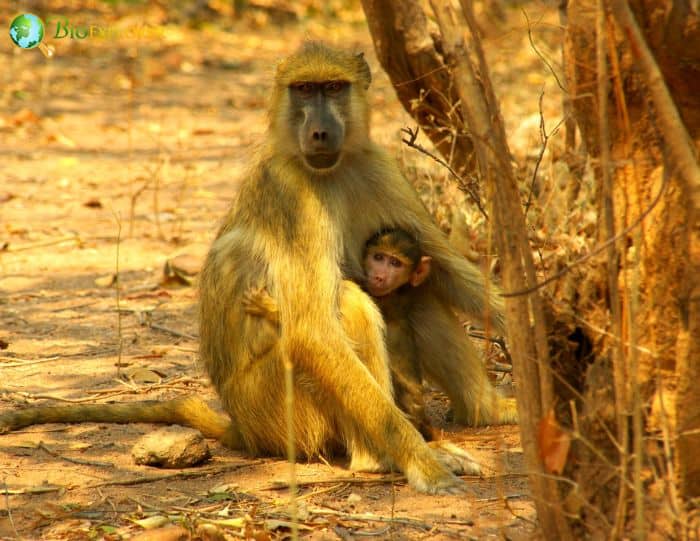
Yellow baboons are omnivores. Based on extensive research published in the International Journal of Primatology, the yellow baboons consumes the following food sources but not limited to:[¶]:
- Natal Orange (Strychnos spinosa).
- Largeleaf Lantana (Lantana camara).
- Reclining Date Palm (Phoenix reclinata).
- Mango (Mangifera indica)
- Baobab (Adansonia digitata)
- Dracaena (Dracaena)
- Garden Tomato (<Solanum um lycopersicum).
- Honeysuckle Tree (Turraea floribunda).
- Triangle Tops (Blighia unijugata).
- Kirk’s Landolphia (Landolphia kirkii).
- Pod Mahogany (Afzelia quanzensis).
- Soursop (Annona muricata)
- East African Copal (Hymenaea verrucosa).
- Tamarind (Tamarindus indica)
- Lagos Rubbertree (Ficus lutea).
- Cantaloupe (Cucumis melo)
- African Oil Palm (Elaeis guineensis).
- Sugar Apple (Annona squamosa).
- Chinese Waterberry (Flueggea virosa).
- Jackfruit (Artocarpus heterophyllus)
- Papaya (Carica papaya)
- African Locust Bean (Parkia filicoidea).
- Abas (Psidium guajava)
- Cashew (Anacardium occidentale)
- African Teak (Milicia excelsa).
- Wild Custard-Apple (Annona senegalensis).
- Duhat (Syzygium cumini)
- Loquat (Eriobotrya japonica)
- Rigid Star Berry (Diospyros squarrosa).
- Milkwood (Tabernaemontana)
- Passionflower (Passiflora edulis)
- Chastetree (Vitex)
- Teak (Tectona grandis)
- Hyphaene (Hyphaene)
- Chinese Banyan (Ficus thonningii).
- Capelins (Mallotus)
- Tallow Wood (Ximenia americana).
- Lowveld Fig (Ficus stuhlmannii).
- Aroma (Dichrostachys cinerea)
- Sycamore Fig (Ficus sycomorus).
- Corrida Yerba De Guava (Geophila repens).
- Wild Coffee (Psychotria)
- Doum Palm (Hyphaene coriacea).
- Broom Cluster Fig (Ficus sur).
- Ilang-Ilang (Cananga odorata)
- Goldenleaf (Chrysophyllum)
- Chinalaurel (Antidesma)
- Ebony Diospyros (Diospyros mespiliformis).
- Mamífero (Mammalia)
- Hexapoda (Insecta)
- Vegetable Ivory Palm (Hyphaene petersiana).
What Eats Yellow Baboons?
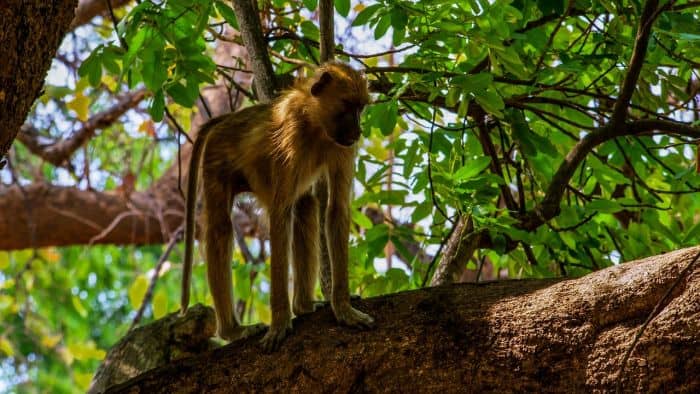
In the wild, yellow baboons are predated by Lions (Panthera leo), Leopards (Panthera pardus) and Cheetahs (Acinonyx jubatus)[§].
Yellow Baboon Facts
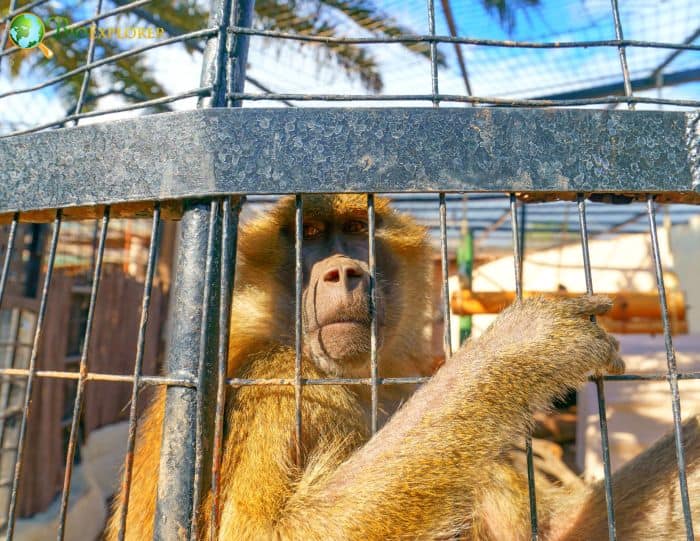
- The specific epithet means “dog’s head” in Greek due to the canine shape of the muzzle and head.
- Yellow baboons live in large multi-male and multi-female herds that contain nests and engage in group activities.
- The average lifespan of the yellow baboon in the wild is around 15 to 20 years; some can live up to 30 years.
- Males and females of Yellow baboons form a linear dominance hierarchy, with higher-ranking members accessing a more significant share of valuable team resources, such as food and mating opportunities.
- When a male is angry, he may shake a few branches and yawn to show off his sharp canines to communicate visually before resorting to physical combat.
Suggested Reading: Different Types of Monkeys In The World
Cite This Page
APA7MLA8Chicago
BioExplorer.net. (2024, April 26). Yellow Baboon. Bio Explorer. https://www.bioexplorer.net/animals/mammals/monkeys/yellow-baboon/.
BioExplorer.net. "Yellow Baboon" Bio Explorer, 26 April 2024, https://www.bioexplorer.net/animals/mammals/monkeys/yellow-baboon/.
BioExplorer.net. "Yellow Baboon" Bio Explorer, April 26 2024. https://www.bioexplorer.net/animals/mammals/monkeys/yellow-baboon/.

























